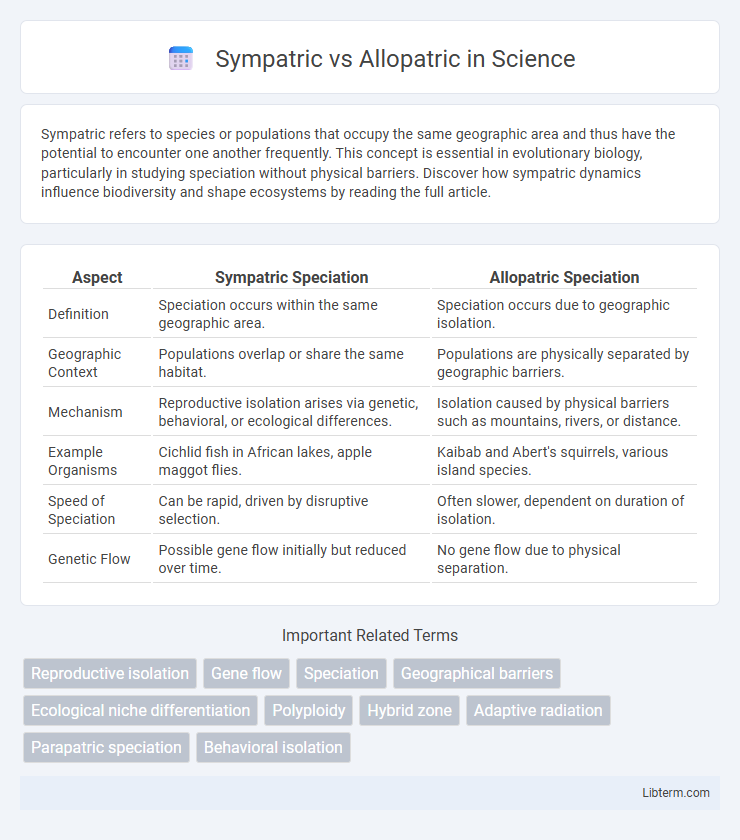Sympatric refers to species or populations that occupy the same geographic area and thus have the potential to encounter one another frequently. This concept is essential in evolutionary biology, particularly in studying speciation without physical barriers. Discover how sympatric dynamics influence biodiversity and shape ecosystems by reading the full article.
Table of Comparison
| Aspect | Sympatric Speciation | Allopatric Speciation |
|---|---|---|
| Definition | Speciation occurs within the same geographic area. | Speciation occurs due to geographic isolation. |
| Geographic Context | Populations overlap or share the same habitat. | Populations are physically separated by geographic barriers. |
| Mechanism | Reproductive isolation arises via genetic, behavioral, or ecological differences. | Isolation caused by physical barriers such as mountains, rivers, or distance. |
| Example Organisms | Cichlid fish in African lakes, apple maggot flies. | Kaibab and Abert's squirrels, various island species. |
| Speed of Speciation | Can be rapid, driven by disruptive selection. | Often slower, dependent on duration of isolation. |
| Genetic Flow | Possible gene flow initially but reduced over time. | No gene flow due to physical separation. |
Introduction to Speciation: Sympatric vs Allopatric
Speciation occurs through mechanisms such as sympatric and allopatric processes, which describe how new species arise. Sympatric speciation happens within a shared geographic area, driven by genetic divergence and reproductive isolation without physical barriers. Allopatric speciation involves geographic isolation, where physical separation prevents gene flow, leading to distinct evolutionary paths and the emergence of new species.
Defining Sympatric Speciation
Sympatric speciation occurs when new species evolve from a common ancestor while inhabiting the same geographic region, without physical barriers to gene flow. This process often involves genetic divergence through mechanisms like polyploidy, disruptive selection, or behavioral isolation. Contrastingly, allopatric speciation requires geographic separation, leading to reproductive isolation and eventual speciation.
Defining Allopatric Speciation
Allopatric speciation occurs when populations of the same species become geographically isolated, preventing gene flow and leading to reproductive isolation through genetic divergence. This process is driven by physical barriers such as mountains, rivers, or distances that separate populations and restrict interbreeding. Over time, isolated populations evolve distinct characteristics, resulting in the emergence of new species.
Key Differences Between Sympatric and Allopatric Speciation
Sympatric speciation occurs within a single geographic area where reproductive isolation arises without physical barriers, often driven by genetic mutations or ecological niche differentiation. Allopatric speciation involves the physical separation of populations by geographic barriers such as mountains or rivers, leading to divergence through genetic drift and natural selection over time. Key differences include the presence of geographic isolation in allopatric speciation versus the overlapping ranges in sympatric speciation, and the mechanisms by which reproductive isolation develops.
Mechanisms Driving Sympatric Speciation
Sympatric speciation occurs when new species evolve from a common ancestor within the same geographic region, driven primarily by mechanisms such as disruptive selection, polyploidy, and behavioral isolation. Disruptive selection facilitates divergence by favoring individuals at extreme phenotypes, while polyploidy, especially common in plants, leads to reproductive isolation through chromosome number changes. Behavioral isolation through mating preferences or habitat differentiation further reinforces reproductive barriers, enabling sympatric populations to diverge genetically despite physical proximity.
Mechanisms Behind Allopatric Speciation
Allopatric speciation occurs when populations of a species become geographically isolated, preventing gene flow and leading to reproductive isolation over time. Mechanisms driving this process include genetic drift, mutation, and natural selection acting independently on each isolated population, causing divergence in traits and behaviors. Geographic barriers such as mountains, rivers, or distance play a crucial role in initiating and maintaining allopatric speciation by restricting interbreeding between populations.
Real-World Examples of Sympatric Speciation
Cichlid fish in African Great Lakes demonstrate sympatric speciation through niche differentiation and mate preference within the same geographic area. Apple maggot flies (Rhagoletis pomonella) exhibit host-race formation by shifting from hawthorn to apple trees, leading to reproductive isolation without physical barriers. Some species of bush frogs in the Western Ghats of India show sympatric speciation driven by variations in mating calls and microhabitat use in overlapping ranges.
Real-World Examples of Allopatric Speciation
Darwin's finches on the Galapagos Islands provide a classic example of allopatric speciation, where geographic isolation led to distinct species evolving on separate islands. The Kaibab squirrel and Albert squirrel in the Grand Canyon also illustrate allopatric speciation, as the canyon acts as a physical barrier causing genetic divergence. Similarly, the Assam macaque populations in the Himalayas demonstrate how mountain ranges contribute to speciation by isolating populations geographically.
Evolutionary Implications and Significance
Sympatric speciation occurs when new species evolve from a common ancestor within the same geographic area, promoting genetic divergence through mechanisms like polyploidy or ecological niche differentiation. Allopatric speciation involves physical barriers separating populations, leading to reproductive isolation and distinct evolutionary paths driven by geographic isolation and natural selection. Understanding these processes is crucial for explaining biodiversity patterns and evolutionary dynamics across ecosystems.
Conclusion: Comparing Sympatric and Allopatric Processes
Sympatric speciation occurs within a shared geographic area through genetic divergence and reproductive isolation without physical barriers, while allopatric speciation arises from geographic separation that limits gene flow. Allopatric processes tend to produce more distinct species due to prolonged isolation, whereas sympatric processes rely on ecological niches and behavioral differences to drive speciation. Understanding these mechanisms highlights their complementary roles in generating biodiversity by shaping species evolution through different environmental and genetic factors.
Sympatric Infographic

 libterm.com
libterm.com